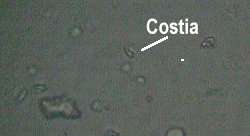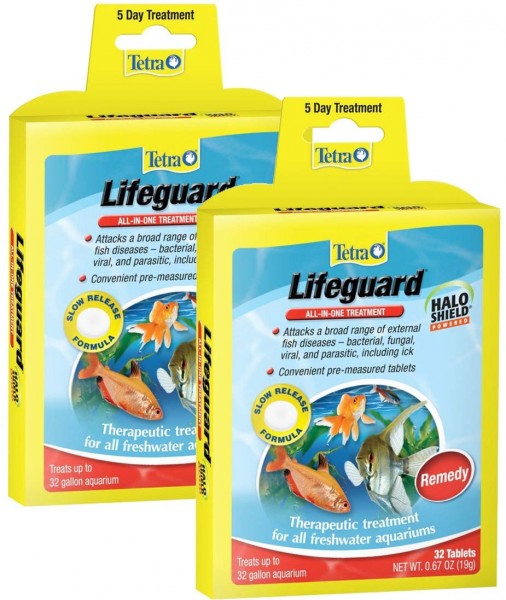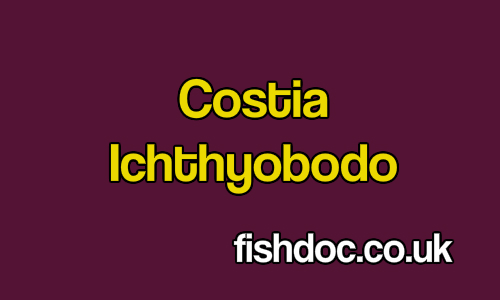A common parasite
As with many fish parasites, small numbers of Costia (or more correctly Ichthyobodo) are not uncommon and appear not be detrimental to the fish’s health. In small numbers these parasites seem to live on cellular debris in a commensalistic relationship with their fish host. Costia occasionally live on the skin and gills of healthy fish and it is believed that the fish’s defences keep the parasite population under control.
Ichthyobodo (Costia ) |
|

Histological section of a gill with a heavy infestation of Ichthyobodo (Costia) attach to the gill epithelium. The parasites feed on the cell contents. Note the pyriform shape, |
|
|
photo: Frank Prince-Iles |
|
It becomes a serious threat when, for various reasons, the parasite becomes established in large numbers. As with all parasite infestations, large numbers will affect fish health by causing serious tissue damage to both skin and gills, as well as secondary effects such as hyperplasia or secondary infections – particularly of the gill.
They can reproduce at a phenomenal rate – under ideal conditions
The main danger from Costia is the rate at which it can reproduce; quickly taking advantage of any shift in the balance of health. It is not unusual to see very sick fish literally alive with parasites (see the fish disease movies). However, the question that has to be asked in such cases is: “is the fish sick because of the heavy parasite infestation, or has it attracted parasites because it is sick?”. At higher temperatures the generation doubling time can be as little as a few hours!
They do not reproduce sexually, they simply divide into two, a reproductive process called binary fission. The conditions that encourage this type of explosive population growth are those that we would expect; that is, stressed or sick fish, poor water quality and/or overcrowding. Under such (ideal!) conditions it reverts to a parasitic existence, attacking living cells with disastrous consequences.
Identification
Costia infestations cause a typical irritation response from the fish. Heavy and laboured ‘breathing’ (judged by watching operculum movements), flashing and rubbing, skin cloudiness caused by excess mucus, focal redness, lethargy. At a later advanced stage (which may be too late for treatment) fish often isolate themselves, sometimes near the water surface or water return. They can also exhibit extreme lethargy with long spells laying on the bottom with clamped fins. I should also point out that these clinical signs are not exclusive to parasite infestations and can be caused by several other factors including adverse water quality.
For an accurate diagnosis a skin scrape and a gill biopsy should be taken as it is not unusual for the skin to be ‘clean’ yet the gills suffering from a severe parasite infestation – or vice versa, or indeed the two areas to be heavily colonized by two different parasite species!
Under the microscope you will probably need 400x magnification to see these small parasites, as they are only 10 -20 µm long (1µm = 1/1000 millimetre). Because they are so small it sometimes helps to rack down the microscope condenser and add a little more contrast. Free-swimming Costia is identified by its characteristic flickering, caused as it turns its crescent-shaped body. It is a fast moving parasite, constantly moving in and out of focus.- Click on the Costia movie to see it live.
When attached to the skin or gill it assumes a pyriform shape and clusters of parasites can sometimes be seen on the edge of gill epithelium in gill biopsies – as seen in the photomicrograph above. One or two parasites per slide is not cause for concern. If numbers are higher than this, treatment and a review of environmental conditions should be the order of the day
Treatment
Treating mild to moderate outbreaks is fairly easy, usually requiring just one treatment. Most proprietary parasite treatments will work. My own preference is malachite and formalin, provided that fish are not suffering from gill damage. Prolonged immersion with potassium permanganate is another option but again this is not advisable if gill damage is suspected. When gill damage is suspected salt offers the safest route as either a bath treatment (20 – 25g/litre for 20 – 30 minutes) or as a long-term immersion at 3-5g/litre.
In advanced and severe cases, resolution may be very difficult because of the numbers of parasites involved, excess mucus and hyperplasia helping to protect the parasites from chemical treatments and the poor health of the fish. In such circumstance tank treatments with chloramine-T and long term salt support is the best option with treatments being repeated until the fish shows signs of improvement.

This is the “easy to get” replacement for Chloramine-T which is a third generation halamid type disinfectant. Tetra worked out the safety issues cleverly.

